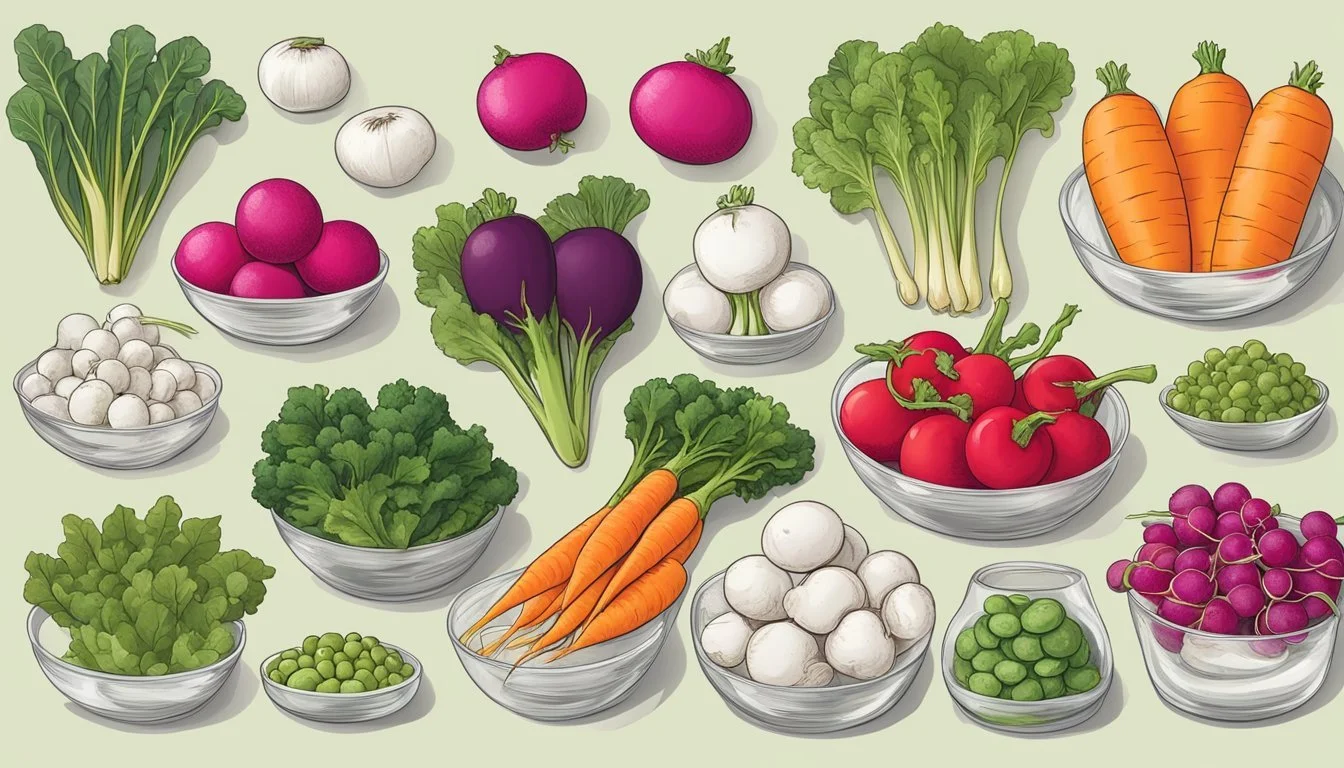Radish Substitutes
Top Alternatives for Your Recipes
Radishes are a common ingredient in various cuisines worldwide, appreciated for their crisp texture and peppery flavor. They add a punch to salads, a crunchy component in tacos, and a sharpness to cooked dishes. However, if radishes are not available or suitable for a certain diet, there are numerous alternatives that can mimic these characteristics.
Substitutes for radish not only have to match its distinctive flavor but also its texture. Options like jicama provide a similar crunch with a mildly sweet and nutty taste, making it a suitable stand-in for raw radish applications. In cooked dishes, horseradish root can be a viable alternative, offering a spicy kick when roasted, which mellows out and brings an earthy nuance to meals.
Understanding the role radishes play in a recipe is crucial when choosing a replacement. Each substitute brings its unique flavor profile and texture to a dish. For example, daikon, a type of white radish known for its mild taste and versatility, can be seamlessly swapped into recipes calling for the common red radish, especially in Asian-inspired dishes. Meanwhile, ingredients like parsnips may visually resemble radishes and can be used in cooking to achieve a similar texture, though the flavor will be sweeter and less spicy.
Understanding Radishes
This section explores the different types of radishes, their nutritional benefits, and the various ways they can be integrated into culinary practices.
Varieties of Radishes
Radishes come in multiple varieties, each with distinct characteristics:
Daikon Radish: A long, white root vegetable with a milder taste compared to smaller red radishes. It is commonly used in Asian cuisine for dishes like kimchi and jjigae.
Watermelon Radish: Named for its green exterior and striking magenta interior, it offers a slightly peppery and sweet flavor.
Red Radish: A small, crisp, and peppery vegetable often used raw in salads.
Korean Radish: Larger and rounder than red radishes, this type is used mainly in Korean dishes such as kimchi.
Pink Radish: Similar to the red radish with a vibrant pink hue and a mild peppery flavor.
French Breakfast Radish: Elongated and mild, with a crisp texture perfect for raw eating.
Nutritional Profile of Radishes
Radishes are a low-calorie food with a variety of nutritional benefits:
Fiber: Radishes contain dietary fiber which aids in digestion.
Vitamin C: A good source of Vitamin C, providing antioxidant properties.
Minerals: They offer minerals such as potassium and calcium.
Folate: Some types of radishes contain folate, which supports cell growth and metabolism.
Nutritional Table for 100g of Raw Red Radish:
Nutrient Amount Energy 16 kcal Water 95.3 g Protein 0.68 g Total lipid 0.10 g Carbohydrate 3.40 g Fiber, total 1.6 g Sugars, total 1.86 g Vitamin C 14.8 mg Calcium 25 mg Iron 0.34 mg Magnesium 10 mg Potassium 233 mg Sodium 39 mg Zinc 0.28 mg Folate, DFE 25 µg
Culinary Uses for Radishes
Radishes are versatile in the kitchen:
Salad: Sliced raw radishes provide a crunchy, peppery addition.
Soup: They can be stewed to infuse a piquant flavor into soups.
Kimchi: Daikon and Korean radishes are fundamental in the fermentation process in making kimchi.
Jjigae: Radishes can be an ingredient in jjigae, a Korean stew, adding depth and flavor.
Each radish type can be a key ingredient in a variety of dishes due to its unique flavor and texture.
Radish Substitutes
Radishes offer a unique peppery taste and crunchy texture that can be difficult to replicate, but various vegetables and non-traditional options are available to achieve a similar effect in recipes.
Daikon as a Substitute
Daikon, also known as Japanese radish or mooli, stands out with its mild flavor and is an excellent replacement for traditional radishes. Its larger size offers a similar crispness, making it an ideal substitute in raw salads and as a garnish.
Root Vegetable Alternatives
Several root vegetables serve as suitable radish substitutes due to their texture and flavor profiles. Jicama is suggested for its crunchy texture and sweet taste. Turnips and beets provide an earthy flavor and are versatile in both cooked and raw dishes.
Cruciferous Vegetable Options
The Brassicaceae family, to which radishes belong, includes cruciferous vegetables like cabbage and napa cabbage that offer a comparable bite. The hearts of these cabbages can closely mimic radish's texture when chopped finely.
Non-Traditional Substitutes
For those willing to experiment, non-traditional substitutes such as apples or bell peppers can offer a crisp texture, while fennel delivers a sweet, slightly anise-like flavor. Cucumber is also a popular choice due to its refreshing crunch.
Horseradish-Related Replacements
Horseradish, particularly the root, is known for its intense, pungent taste. It can be grated and mixed with vinegar and salt to adjust the spiciness level, making it a powerful condiment to replace radish's peppery flavor in some recipes.
Selecting the Best Substitute
When seeking a radish substitute, one should consider the desired flavor, texture, and the substitute’s availability. Matching these characteristics as closely as possible will yield the best results in any dish.
Based on Flavor Profile
The centerpiece of finding a radish replacement hinges on aligning the flavor profile of the substitute with that of the radish. A radish is known for its peppery taste and can range from mild to spicy. For those looking for a spicy kick, horseradish root can provide a similar heat, but it is notably stronger and should be used in moderation. If a mild flavor is preferred, jicama offers a sweet and nutty flavor that complements salads much like radishes, though it is less piquant.
Considering Texture
Texture plays a crucial role in replicating the radish experience. Radishes are crunchy and juicy, and a good substitute should mimic this texture to maintain the integrity of the dish. Jicama again stands out as a firm yet juicy option, preserving the desired crunch. On the other hand, for cooked dishes where a soft texture is acceptable, roasted horseradish can become easily chewable, resembling the softness of roasted radishes.
Availability and Seasonality
Radishes are not always in season, so one must consider the availability of an adequate substitute. Jicama is generally available year-round in supermarkets, making it a versatile and accessible alternative. On the contrary, horseradish, though widely used, might have varying availability depending on regional and seasonal factors. One must also take into account their personal preference and the context in which the radish substitute will be used to ensure that the substitute's availability aligns with the times the dish will be prepared.
Creative Uses of Radish Substitutes
Radishes bring a unique blend of spiciness and crunch to dishes, but when they are not available, several substitutes provide their own distinctive qualities to a meal. This section explores how to effectively use alternative ingredients to mimic or enhance the flavors and textures that radishes typically contribute.
In Salads and Slaws
Jicama, with its sweet and nutty flavor, can replace radishes at a 1:1 ratio in salads, adding a similar crunch. It's particularly effective when used raw, complementing greens with its crisp texture. Kohlrabi, another viable substitute, offers a slightly sweeter taste. Both vegetables are rich in dietary fiber, contributing to a balanced diet.
As a Component in Soups and Stews
Adding substitutes like turnips or daikon to soups can replicate the radish's effect. Turnips, which have a milder taste, become tender when cooked and are ideal in stews. Daikon, a larger East Asian radish variant, maintains its structure in high heat, making it perfect for long-simmered soups. The inclusion of these vegetables not only imparts complex flavors but also boosts the vitamin content.
Enhancing Flavor with Substitutes in Cooking
Bell pepper slices provide a sweet and mildly spicy essence, especially when substituted in cooked dishes. Celery offers a contrasting texture and a subtle, earthy spice, suitable for sautéed recipes or stir-fries. Additional spices such as dried or fresh herbs can be used alongside these substitutes to align the flavor profile more closely with that of radishes.
Frequently Asked Questions
This section addresses common queries about substituting radishes in culinary preparations, considering nutritional profiles, cultural dish requirements, and how to choose the best substitutes based on specific recipes.
Choosing Substitutes Based on Recipes
When selecting a substitute for radish, consider the recipe's requirements for texture and flavor. For instance, jicama can be used at a 1:1 ratio for radishes in Mexican dishes, offering a similar crunchy texture with a sweeter taste. In Korean recipes, like kimchi, Korean radish may be replaced with daikon, also known as Japanese radish, which provides a comparable flavor profile and water content.
Nutritional Concerns with Substitutes
It's important to consider the nutritional differences when substituting radishes. Radishes are known for their vitamin C content and fiber, contributing to a nutritious diet. Substitutes such as jicama still provide a high water content and fiber, but the vitamin C levels may vary. Always cross-reference the nutritional value of the substitute to ensure it aligns with dietary needs.
Cultural Preferences and Substitutions
Different cultures prefer specific radish varieties and substitutes based on traditional flavors and availability. For example, in Mexican cuisine, jicama is often used for its sweet, nutty flavor, while Korean dishes may favor Korean radishes for their unique taste. Substitutions should respect the cultural preferences and aim to match the original vegetable's role in the dish as closely as possible.




